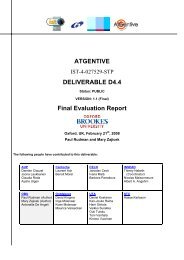Industry Roadmap to Web 3.0 & Multibillion Dollar ... - INSEAD CALT
Industry Roadmap to Web 3.0 & Multibillion Dollar ... - INSEAD CALT
Industry Roadmap to Web 3.0 & Multibillion Dollar ... - INSEAD CALT
You also want an ePaper? Increase the reach of your titles
YUMPU automatically turns print PDFs into web optimized ePapers that Google loves.
Where do the shared meanings and knowledge in <strong>Web</strong> <strong>3.0</strong> come from?<br />
From both people and machines. And, <strong>to</strong> start with, from the <strong>Web</strong> itself.<br />
Knowledge exists in many forms in <strong>to</strong>days <strong>Web</strong>.<br />
All computing processes represent some type of<br />
knowledge in some way in order <strong>to</strong> process information,<br />
for example: knowledge about how information<br />
is organized in order <strong>to</strong> search it; rules that<br />
tell a computer program how <strong>to</strong> make a decision;<br />
or action steps <strong>to</strong> take <strong>to</strong> complete a task.<br />
The problem is that existing knowledge on the <strong>Web</strong><br />
is fragmented and difficult <strong>to</strong> connect. It is locked<br />
in data silos and operating system file system<br />
formats. Knowledge is hidden in object-oriented<br />
black boxes and layers of stack architecture. It is<br />
embedded in program code and squirreled away<br />
in proprietary algorithms.<br />
<strong>Web</strong> <strong>3.0</strong> changes this. The convergence of pattern<br />
discovery, deep linguistics, and on<strong>to</strong>logical<br />
symbolic reasoning technologies make it feasible<br />
<strong>to</strong> au<strong>to</strong>matically extract embedded and intrinsic<br />
knowledge from <strong>to</strong>days <strong>Web</strong>. Evolution of semantic<br />
social computing will enable communities <strong>to</strong><br />
create, curate, and share knowledge in human<br />
readable and machine executable forms.<br />
The diagram below contrasts knowledge-centric<br />
and information-centric patterns of computing. In<br />
<strong>Web</strong> <strong>3.0</strong>, end-user development will increase as<br />
computers help generate intelligent services and<br />
manage application functionality, security, versioning<br />
and changes au<strong>to</strong>nomically.<br />
Executive<br />
Summary<br />
7<br />
Below:<br />
What Are Knowledge-centric Patterns of Computing?<br />
Pattern Information-centric Knowledge-centric<br />
Who develops software<br />
behaviors, knowledge<br />
structures, and content?<br />
How are different<br />
expressions of knowledge<br />
handled?<br />
Where do knowledge & logic<br />
in the system come from?<br />
What are the patterns for<br />
system learning?<br />
What are the patterns for<br />
knowledge representation<br />
and computation?<br />
What are the patterns for<br />
underlying infrastructure?<br />
What are the patterns for<br />
security?<br />
What are patterns for<br />
versioning and change<br />
management?<br />
Producers and enterprises are developers.<br />
Separate technologies for documents (data,<br />
content), models, and behaviors. Closed semantics,<br />
hardwired.<br />
At design time, from people. At new release,<br />
from people. No run-time learning.<br />
No system learning.<br />
No au<strong>to</strong>nomics.<br />
New knowledge requires new version of code.<br />
Process-centric, cycle time intensive. Directional<br />
algorithms and procedures. Embedded<br />
knowledge — logic, structure locked in code.<br />
Relational opera<strong>to</strong>rs. First-order logic.<br />
Predefined configurations.<br />
Black-box objects.<br />
Stacks.<br />
Single processors.<br />
Local s<strong>to</strong>res.<br />
Separate role-based security for each system.<br />
Black boxes, lack of transparency, and human<br />
intervention make network security problematic.<br />
Manual change management and versioning.<br />
Human architected. Central planning. Brittle.<br />
Prosumers (consumers) and peer-<strong>to</strong>-peer producers (groups,<br />
communities) do it themselves.<br />
Unified platforms handle documents, models & behaviors<br />
interchangeably, including pictures & natural language. Massive<br />
open local semantics, available everywhere.<br />
At design time, from people.<br />
At run time, from user input and from system learning.<br />
System learns and evolves from use by people.<br />
Machine observes & learns from environment.<br />
Au<strong>to</strong>nomics — self* learning and adaptation.<br />
Data-centric, s<strong>to</strong>rage-intensive. Semantic opera<strong>to</strong>rs. Sequence<br />
neutral graph reasoning. External declarative knowledge structures.<br />
Semantic and value-based reasoning with full spectrum<br />
of logic.<br />
Adaptive, self-optimizing configurations. Ubiqui<strong>to</strong>us semantic<br />
<strong>Web</strong>s, meshes & grids. Transparent semantic agents. Multi-core,<br />
multi-threaded processors. Federated s<strong>to</strong>res and processes.<br />
Semantic ecosystems and social au<strong>to</strong>poeisis (self-organization,<br />
planning, etc.).<br />
Au<strong>to</strong>nomic identity and security with concept level granularity<br />
across all IP entities, relationships, services, etc. Building block<br />
transparency = security by design.<br />
Au<strong>to</strong>mated change management & versioning. Au<strong>to</strong>nomic intellectual<br />
property, emergent behaviors, self-managed. Robust.<br />
Source: Project10X<br />
2007, 2008 Copyright MILLS•DAVIS. All rights reserved
















